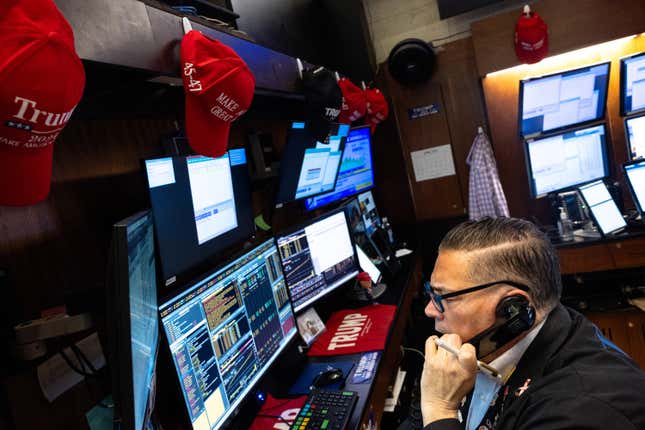
In This Story
It’s the end of the world as we know it, but investors seem to feel (mostly) fine, judging by the stock market.
Stocks closed mainly higher on Tuesday ahead of an announcement by Donald Trump on Wednesday in which he may unveil immediate tariffs on almost all U.S. trading partners. The S&P 500 ended 0.4% higher, the Nasdaq Composite gained 0.9%, and the Dow Jones Industrial Average shed 11.8 points.
This muted performance came even as the ISM manufacturing index for March came at 49.0 — below expectations and indicating a contraction — with its forward-looking elements pointing to even deeper pessimism, Goldman Sachs (GS-1.29%) said. The JOLTS job opening number also fell by more than expected.
Many investors are anticipating that Trump’s press conference will resolve many of the questions surrounding increased import taxes. While markets hate uncertainty, they tend to rally after it’s been resolved, LPL Financial’s (LPLA-1.34%) strategists wrote in a report.
“There will still be trade policy uncertainty after that date, but the Trump administration is expected to clear up some of the biggest questions investors have right now,” they wrote. “We don’t want to sound too bullish, and we remain cautiously neutral right now, but the opportunity for upside is there.”
But the Trump administration’s track record gives little reason to believe that April 2 will mark the end to ambiguity on trade, Michael Madowitz, the Roosevelt Institute’s principal economist, told Quartz. Even clarity wouldn’t prevent “scary” escalation scenarios — which Trump makes more likely with his confrontational stance.
There’s also the larger question as to whether Trump’s big increases in tariffs are purely a negotiating tactic — a view many investors and observers still seem to hold — or are part of a permanent, ideologically driven shift toward protectionism and away from 80 years of a U.S. push for freer trade.
A major, long-term push to make most U.S. production domestic would take years and involve the deliberate infliction of economic pain, Chris Grisanti, MAI Capital Management’s chief market strategist, told Quartz last month. Costs would jump and stay high for an extended period.
“This is taking on a big structural problem, but the question is whether the cure is worse than the disease,” he said. And with many goods now so complicated, with parts sourced worldwide, seeking to move output 100% onshore would be like “unscrambling eggs.”
Trump’s push away from U.S. foreign policies in place for decades will have long-term economic consequences that may simply be too large for investors to absorb, said Marta Norton, Empower’s chief investment strategist.
“Even if the tariffs are not as severe as painted, it’s still a sea change,” Norton said. “People have a hard time realizing that this a possibility given the state of play for the past couple of decades. It’s so immense that it’s hard to imagine.” However, there’s still a chance the duties will be tactical, she added.